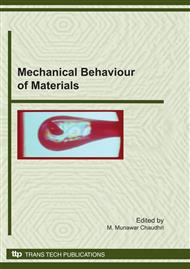[1]
M.F. Ashby: Phil. Mag. Vol. 21 (1970) p.399.
Google Scholar
[2]
N.A. Fleck and J.W. Hutchinson: J. Mech. Phys. Sol. Vol. 41 (1994) p.1825; also, Adv. Appl. Mech., Vol. 33 (1997) p.295.
Google Scholar
[3]
L.M. Brown: Slip circle constructions for inhomogeneous rotational flow, Materials Science Forum Vol. 550 (2007) pp.105-107.
DOI: 10.4028/www.scientific.net/msf.550.105
Google Scholar
[4]
M.M. Chaudhri: Dislocations and Indentation, Chapter 12 in Dislocations in Solids, F.R.N. Nabarro and J.P. Hirth, Eds., Elsevier B.V., (1994).
Google Scholar
[5]
H. Czerski and L.M. Brown: J. Phys. D.: Applied Physics Vol 41 (2008) pp.1-5.
Google Scholar
[6]
D. Tabor, The Hardness of Metals (1951), Clarendon Press, Oxford; paperback edition (2000).
Google Scholar
[7]
N.A. Stelmashenko, M.G. Walls, L.M. Brown, and Yu.V. Milman, Acta metal. mater., Vol 41 (1993) pp.2855-2865.
Google Scholar
[8]
J. G. Swadener, E. P. George. And G. M. Pharr: J. Mech. Phys. Sol. Vol 50 (2002) p.681.
Google Scholar
[9]
Yong Lee Lim and M. Munawar Chaudhri: Phil. Mag. Vol A 79 (1999) p.2979.
Google Scholar
[10]
L.M. Brown, in Plasticity, Failure and Fatigue in Structural Materials - from Macro to Nano, Proceedings of the Hael Mughrabi Honorary Symposium, (2008).
Google Scholar
[11]
T. Narutani and J. Takamura: Acta metall. mater. Vol 39 (1991) p.2037 - (2049).
Google Scholar
[12]
Fuquian Yang, Lingling Peng, and Kenji Okazaki; Materials Characterization Vol 57 (2006) pp.321-325.
Google Scholar
[13]
X. Hou, A.J. Bushby, and N.M. Jennet; J. Phys. D: Applied Physics Vol 41 (2008) 074006 (7pp).
Google Scholar
[14]
X. Hou; Geometrical Size Effects in the Plasticity of Metals by Micromechanical Testing: Ph.D. thesis for Queen Mary College, University of London, (2009).
Google Scholar
[15]
K. K. McLaughlin and W. J. Clegg; J. Phys. D: Applied Physics Vol 41 (2008) 074007 (5pp).
Google Scholar
[16]
N. Stelmashenko; Microstructual Studies of Plastic Indentations at Low Loads: Ph.D. thesis for the University of Cambridge, (1995).
Google Scholar
[17]
N. Gane and J. M. Cox; Phil. Mag. Vol 22 (1970) p.881.
Google Scholar
[18]
Pethica, J. B., Hutchings, R. and Oliver, W. C.; Phil. Mag. Vol A48 (1983) p.593.
Google Scholar
[19]
Y. H. Lee, J. H. Hahn, S. H. Nahm, J. I. Jang, and D. Kwon; J. Phys. D: Applied Physics Vol 41 (2008) 074027 (5pp).
Google Scholar
[20]
X. L. Wu, Y. T. Zhu, Y. G. Wei, and Q. Wei; Phys. Rev. Lett. Vol 103 (2009) 205504 (4pp).
Google Scholar
[21]
Z. S. Basinski and S. J. Basinski; Dislocations in Solids Vol. 4 (1979), F. R. N. Nabarro, Ed., (North Holland, Amsterdam) p.26.
Google Scholar
[22]
R. Madec, B. Devincre, and L. P. Kubin, Phys. Rev. Lett. Vol. 89 (2002) 255508 (4pp).
Google Scholar
[23]
D. Tabor, The Hardness of Metals, Oxford University Press, New York and Oxford, 1951, reissued as a paperback in the Oxford Classics Series, (2000).
Google Scholar
[24]
K. L. Johnson; Contact Mechanics, Cambridge University Press, Cambridge U.K., New York, Melbourne, (1985).
Google Scholar
[25]
B. W. Mott, Microindentation Hardness Testing, Butterworth, London, (1956).
Google Scholar
[26]
Oliver, W. C. and Pharr, G. M.; Journal of Materials Research Vol 7, (1992), p.1564; also Vol 19 (2004) p.3.
Google Scholar
[27]
Kalei, G. N.; Mashinovedenie Vol 4, (1968) p.105 (in Russian).
Google Scholar
[28]
Feodor M. Borodich and Leon M. Keer; International Journal of Solids and Structures, Vol 41 (2004) p.2479. This article reviews work on tip-shape functions.
Google Scholar
[29]
D. Grabco, O. Shikimaka, and E. Harea; J. Phys. D. Appl. Phys. Vol 41 (2008) 074016 (9pp).
Google Scholar


